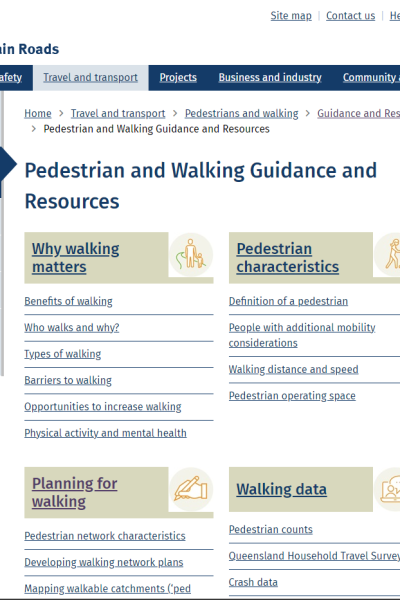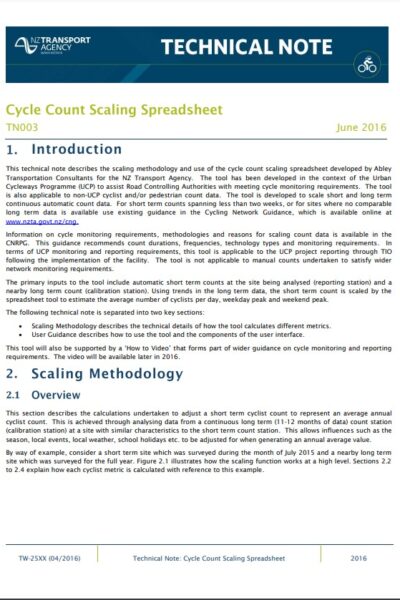Resources
This page contains some key resources on walking and cycling, including an archive of the documents produced by the Australian Bicycle Council.
| Date Added | |||
|---|---|---|---|
 |
Evaluation and implementation of Shared Spaces in NSW Transport for NSW Foundational research designed to support shared space design concepts and applications in NSW, delivered by Transport for NSW in partnership with the University of Technology Sydney. |
16/02/2024 | View |
 |
Pedestrian and Walking Guidance and Resources Department of Transport and Main Roads, Queensland Including:
|
13/10/2023 | View |
 |
Safe Active Streets Pilot Program Evaluation Department of Transport WA The Safe Active Street (SAS) Program’s vision is to create shared street spaces that provide a convenient travel option within a safe and attractive environment for people riding and walking of all ages and abilities. To achieve the vision of the SAS Program the following objectives have been established:
The SAS Pilot Program is being evaluated in line with DoT’s SAS Pilot Program Evaluation Plan, which has adopted a summative evaluation framework that considers impacts, cost effectiveness and comparability between projects. The SAS Pilot Program Evaluation Plan clearly details in an Outcomes Measurement Framework the specific indicators, targets, and data sources to adequately evaluate the program. |
05/04/2023 | View |
 |
Research Report 439 Generation of walking, cycling and public transport trips: pilot study Waka Kotahi NZ Transport Agency This research investigated a method for collecting data relating to walk, cycle and public transport trips to land-use activities. A method needed to be developed that would require a short questionnaire to ensure higher sample rates, while also providing reliable and consistent results. This data could subsequently be used in calculating trip rates for walk, cycle and public transport trips, when combined with trip rate units such as floor area. Multi-modal trip data has been collected for some time in the UK. The survey method developed in this research was simpler than the UK method by interviewing in only one direction for the vast majority of land uses, apart from residential where the recommended method was to interview in both directions. A face-to-face questionnaire method was developed over a series of different site surveys in Auckland, Wellington and Christchurch during 2010. The research also identified that collecting non-car mode trip information through purely observer methods was not sufficiently accurate and that simple questionnaire surveys were necessary with clear instructions from the survey organiser to ensure all relevant information would be collected. |
07/04/2022 | View |
 |
Research report 436 Benefits of new and improved pedestrian facilities - before and after studies Waka Kotahi NZ Transport Agency Walking is an essential mode of transport. New and improved pedestrian facilities promote walking and provide greater access and mobility within our communities. The NZ Transport Agency has recently updated the procedures for the evaluation of pedestrian improvement projects. The benefit factor applying to new pedestrian trips was increased from $0.50 to $2.70/km, making pedestrian facility improvement projects more economically viable. Thus, estimating the increase in pedestrian flows (as opposed to simply recording existing pedestrian flows) is now important in the economic evaluation of new or improved facilities. This research analysed case studies at eight New Zealand sites where the implementation of new pedestrian facilities (or the improvement of existing facilities) led to increased pedestrian usage and improved perception of the sites. The study recorded pedestrian rates both before and after facility implementation, and analysed accompanying factors such as safety, delay and directness. It also tried to develop an expected pedestrian-usage model, based on before and after data analysis, for planners and funding agents to use when planning new or improved facilities, and for use in project evaluation. Finally, a monitoring database containing before and after pedestrian count data for various new and improved pedestrian facilities, along with a list of the accompanying factors mentioned above, was developed for future use. |
07/04/2022 | View |
 |
Non-motorised user monitoring technology ViaStrada |
07/04/2022 | View |
 |
Monitoring Walking and Cycling: Creating Vibrant Towns and Cities Waka Kotahi NZ Transport Agency |
07/04/2022 | View |
 |
Programme/project logic models Waka Kotahi NZ Transport Agency The links provide different guides to developing programme/project logic models. |
07/04/2022 | View |
 |
Healthy Streets Healthy Streets Towns and cities everywhere are facing the challenge of keeping communities healthy and happy. Healthy Streets® offers clients around the world an evidence-based approach to creating fairer, sustainable and attractive urban spaces. |
07/04/2022 | View |
 |
Benefits management guidance Waka Kotahi NZ Transport Agency This guidance is to help transport planners, business case writers and anyone involved in transport investment understand the Land Transport Benefits Framework and how to use benefits management in their work. |
07/04/2022 | View |
 |
Technical note #3: Cycle Count Scaling Spreadsheet Waka Kotahi NZ Transport Agency Describes scaling methodology and use of the Cycle count scaling spreadsheet tool, used to scale permanent and short-term count data for average daily cyclist values |
19/10/2021 | View |
 |
Urban Cycleways Programme: National monitoring and data reporting requirements Waka Kotahi NZ Transport Agency Outlines the national monitoring and reporting requirements for the Urban Cycleways Programme (UCP) projects. Includes best practice methodologies for measuring the success of new cycle infrastructure as well as wider network monitoring. |
18/08/2021 | View |
 |
Monitoring and Reporting Waka Kotahi NZ Transport Agency A description of the monitoring required, particularly once the implementation of the cycle network plan has started. |
18/08/2021 | View |
 |
Cycling Standards and Guidance Waka Kotahi NZ Transport Agency Cycling network guidance – planning and design (CNG) framework aims to promote a consistent, best-practice approach to cycling network and route planning throughout New Zealand. |
18/08/2021 | View |
